I'm a train guy and an anime fan, as probably evidenced by some of the photographs you see here. I'll be posting about Japanese trains frequently as those are my specialty, but of course you can ask about other trains too. Any photographs I use that are not mine will have the source linked below in the text.
Don't wanna be here? Send us removal request.
Photo

Fallen Flags: Takachiho Railway This post is going to be a bit different from most. This post will not be focusing on one train, but an entire railroad, as well as the trains operating on it. Today, we’re talking about the Takachiho Railway.
The Takachiho Railway was a suburban railroad operating in Miyazaki Prefecture in Kyushu. The company was initially founded on 12 December 1988 and was based in the town of Takachiho. The company only operated one line throughout its entire existence, the aptly-named Takachiho Line. The line was a former JR Kyushu line that was 31.1 miles (50 kilometers) in length, consisting of nineteen stations: Nobeoka, Nishi-Nobeoka, Mukabaki, Hosomi, Hyūga-Okamoto, Hakiai, Soki, Kawazuru, Kamizaki, Hayahito, Kamegasaki, Makimine, Hyūga-Hachinohe, Ami, Hinokage Onsen, Kagemachi, Fukasumi, Amanoiwato and Takachiho. A second section which was never built stretching from Takachiho would have consisted of an additional five stations: Ueno, Tahara, Kawachi, Hinata-Tomari and Takamori.
The line was originally opened on 20 February 1935 by the Japanese National Railways (predecessor company to the JR Group). On 1 April 1987, the JNR was privatized citing financial issues, with the JR Group taking over operations of all JNR lines. The railroad was subsequently converted to third-second standards on 28 April 1989, and the Takachiho Railway took over operations on that day.
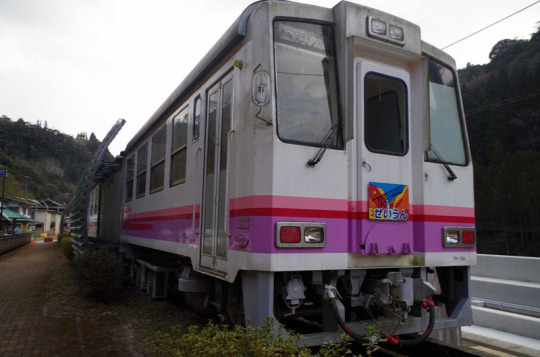
To prepare for the handover of ownership, the Takachiho Railway ordered seven diesel railcars from Niigata Tekkō (now Niigata Transys). These were classified as the TR-100 and TR-200 series, which were generally identical apart from seating arrangements. The cars in general were based on the Kumagawa KT-100 and 200 series cars and the Matsuura MR-100, 200 and 300 series cars.
Five TR-100 series cars were manufactured, all in April 1989 by Niigata Tekkō. They were numbered TR-101 to TR-105 and all given nicknames: Shiroyama, Wakaayu, Hiei, Seiun and Kariboshi for TR-101 to TR-105 respectively. They were equipped with the DMF13HS prime mover and a member of the NDC diesel railcars deigned by Niigata Tekkō.
Two TR-200 series cars were manufactured, both in April 1989 by Niigata Tekkō. They were numbered TR-201 and TR-202 and also given nicknames: Kagura and Unkai for TR-201 and TR-202 respectively. These were equipped with the same DMF13HS prime movers and were also a member of the NDC diesel railcars.

In 1991, another set of diesel railcars was ordered by Takachiho Railway for sightseeing purposes. Two additional cars with streamlined front ends were then manufactured by Niigata Tekkō in July 1991; these were designated TR-300 series cars and numbered TR-301 and TR-302. Both cars were not given nicknames.
The cars were single-ended diesel railcars similar to that of the Akita Nairiku Jūkan AN8900 series cars. The cars were powered by the same DMF13HS prime movers as the TR-100 and TR-200 series cars. Due to their single-cab nature, these often ran in tandem with the TR-100 and TR-200 series cars, as shown above in the photo. On rare occasions, the cars would run in tandem with each other, as shown below.

In 2003, a new series of sightseeing diesel railcars were ordered by Takachiho Railway from Niigata Transys; these were designated the TR-400 series cars. With the introduction of the TR-400 series cars, the TR-300 series cars were put out of service and retired on 14 March 2003. The TR-300 series cars were then struck from the roster on 30 September the same year and displayed outside the Kagura Shuzo headquarters along the line; this is where it remains today. I’ll get to the preserved cars later on.
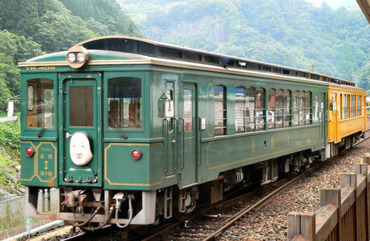
The TR-400 series cars were introduced on the line on 21 March 2003. Both cars were manufactured in March 2003 and feature the DMF13HZ prime movers. The cars, TR-401 and TR-402, were both given nicknames: Tadjikarao and Amanouzume respectively, but when together the entire train was known as the Torokko Kagura. Their appearance was based on the retro-style cars used by other railroads, such as the Minamiaso MT-3010 series and the Matsuura MR-500 series. Both cars were also sponsored; TR-401 was sponsored by the Japanese Lottery Association, while TR-402 was sponsored by the International Convention Resort Miyazaki.
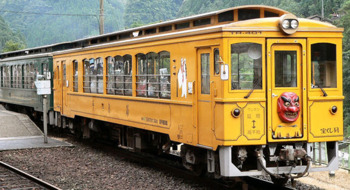
Everything was all fine and dandy on the Takachiho Railway, until... disaster struck.
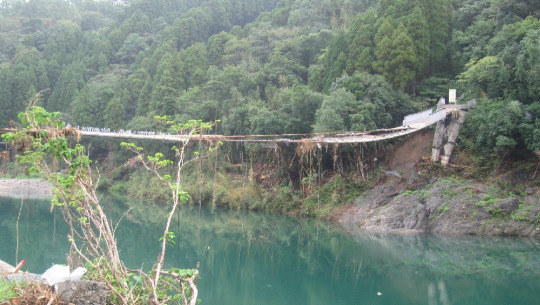
On 6 September 2005, Typhoon Nabi made landfall in Kyushu, causing massive destruction around the island. The Takachiho Railway was not spared of the typhoon’s wrath; the typhoon wrecked bridges and other infrastructure, forcing a temporary closure of the line while the infrastructure was rebuilt.
Just some three months later on 9 December, the railroad’s management abandoned restoration efforts for the entire line as the company was unable to bear the costs of the restoration, with discussion moving to simply operating on the stretch of line between Makimine and Takachiho where damage was relatively minor. Just eleven days later on 20 December, all partial restoration work was called off and the company was reorganized. The stretch of line between Nobeoka and Makimine Stations subsequently suspended all operations on 5 September 2006, before officially declaring that stretch of line permanently closed on 6 September 2007.
Reeling from the financial strain put upon them by the damage caused by the typhoon, the management of the Takachiho Railway declared that they were closing the stretch of the line spanning Makimine and Takachiho on 27 December 2007, with the change to take effect the next year.
With the impending closure of the line, the assets of the line were handed over to Takachiho Torokko Railway Co. Ltd., now known as the Takachiho Amaterasu Railway. On 28 December 2008, the stretch of line between Makimine and Takachiho closed and the line fell silent. The company dissolved on 6 January 2009 and was liquidated by early March 2009, marking the demise of the Takachiho Railway; the last private railway in the Miyazaki region of Kyushu had fallen silent, leaving the only rail transport around the area being operated by JR Kyushu. Transport between Nobeoka and Makimine would now be handled by Miyazaki Kōtsū via a bus line. And now, about the rolling stock. How many of the railroad’s rolling stock still survive today? Let’s find out.
TR-100/200 series TR-101, TR-104, TR-105, TR-201 and TR-202 are known to survive today.

TR-101 and TR-202, Shiroyama and Unkai, are both located at the disused Takachiho Station. Of the two however, only TR-202 is maintained in operational condition, are is operated on occasion by the Takachiho Amaterasu Railway, although such occasions are noted as being somewhat uncommon.
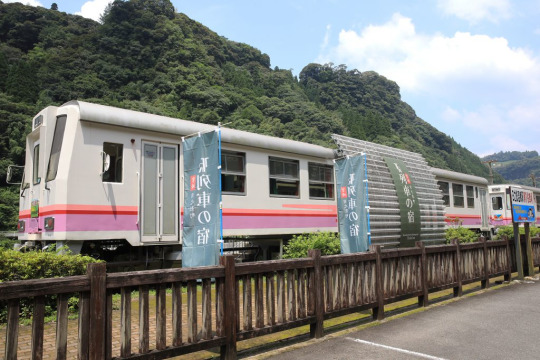
TR-104 and TR-105, Seiun and Kariboshi, are preserved back to back in Hinokage. They have since been converted into an accommodation space named the TR Train Inn. All three surviving TR-100 series locomotives are not in operational condition.

TR-201, Kagura, was transferred to the ASA Seaside Railway on Shikoku. It entered service on 28 August 2009 and nicknamed Takachiho; the railcar was redesignated as the ASA-300 series on the ASA Seaside Railway. With the impending introduction of dual-mode vehicles on the ASA Seaside Railway, the ASA-300 and all other diesel railcars on the railroad are slated to be retired on 30 November 2020.
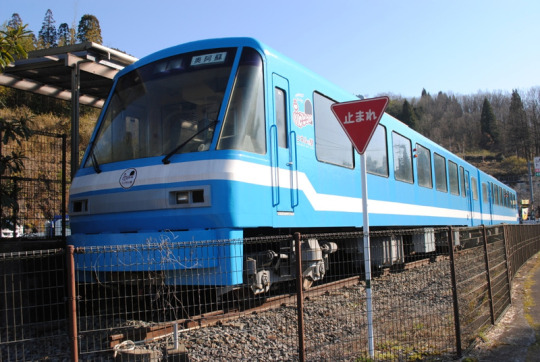
Both TR-300 series cars were retired in 2003 and immediately moved to a “tunnel station” at an unfinished portion of the Takachiho Line, where it remains today. Ownership was transferred to Kagura Shozo, whose headquarters are located along the line. The train was initially painted red, but was repainted blue around 2018.
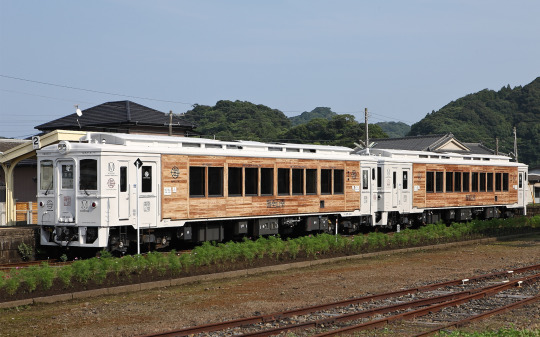
The two TR-400 cars were, ironically, bought by JR Kyushu; the original owners of the Takachiho Line. They were then converted into the Umisachi Yamasachi Joyful Train set and given an extensive external makeover overseen by Eiji Mitooka and his company Don Design Associates, fitted with musical horns composed by Minoru Mukaiya and all the luxury fixings. The trains entered service on 10 October 2009, designated as the KiHa 125-400 series cars. Well, as for the other cars...
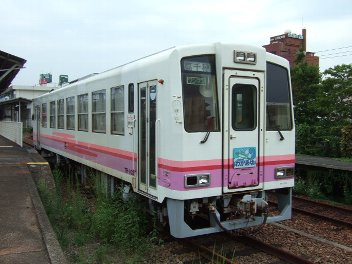
TR-102, Wakaayu, was preserved at Nobeoka Station from September 2005, being exposed to the elements: the railcar has since been scrapped and no longer exists. As for TR-103, well... let me let the following image explain.
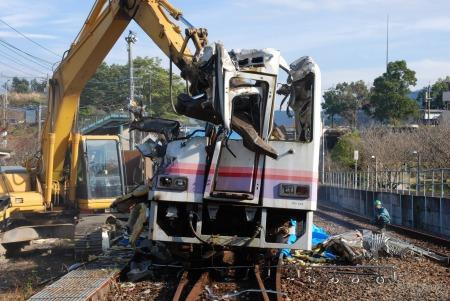
Unfortunately, TR-103, Hiei, also met its final fate at the crusher. However, not all stories have sad endings though.
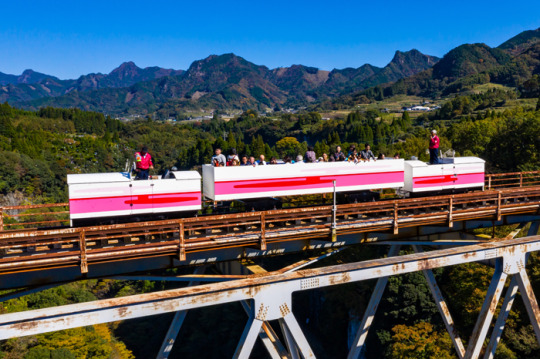
While the Takachiho Railway no longer exists, the Takachiho Line remains; a small stretch of it is currently being used by the Takachiho Amaterasu Railway, operating a set of Tokosangyo Super Cart locomotives around the abandoned line; the company also recently purchased a Grand Super Cart (shown above), an enlarged version of the Super Cart. The Super Carts ferry sightseers from their offices at Takachiho Station to the Takachiho Bridge before turning back to Takachiho (the other end of the Takachiho Bridge is cordoned off with fencing); the company plans to extend its operations to Hinokage Onsen Station in the future. The company also operates TR-202 on occasion. So yes, stories like this can indeed have happy endings.
IMAGE SOURCES
Header: https://www.welcomekyushu.jp/feature/2017/family/10miyazaki.html TR-104: https://ameblo.jp/rx7fd3s917/entry-12591905779.html TR-300: https://japanese-autobus.at.webry.info/201003/article_16.html TR-300 tandem: https://www.mlit.go.jp/tetudo/nandemo/takatiho.html TR-402: http://js3vxw.cocolog-nifty.com/photos/takachiho/tr402.html TR-401: http://js3vxw.cocolog-nifty.com/photos/takachiho/tr401.html Typhoon damage: https://ytken.exblog.jp/41813/ TR-101/202: https://commons.wikimedia.org/wiki/File:TR202_and_TR101_at_Takachiho_Station_(32698613964).jpg TR-104/105: https://hinokage-kanko.jp/contents/tr列車の宿/ ASA-301: http://netrain.makibisi.net/trainphoto/kochi/asakaigan/300.htm TR-300 preserved: https://ameblo.jp/week7rx/entry-12440368287.html Umisachi Yamasachi: https://www.jnto.go.jp/scenic-railways/list/limited-express-umisachi-yamasachi/ TR-102: http://marshland.uunyan.com/tetsu/zenkoku/jpg/1465takachiho/tr100_04.JPG TR-103 scrapped: https://www.pawanavi.com/hyuugajikan/archives/2008/12/post_396.html Grand Super Cart: https://www.lotascard.jp/column/travel/kyushu/11715/
#高千穂鉄道#TakachihoRailway#高千穂TR-100形#高千穂TR-200形#高千穂TR-300形#高千穂TR-400形#TR-100形#TR-200形#TR-300形#TR-400形#TakachihoTR-100#TakachihoTR-200#TakachihoTR-300#TakachihoTR-400#FallenFlags
0 notes
Photo



In Memoriam: ASA Seaside Railway ASA-100/200/300 series
Well, it’s been ages since I’ve updated this blog; I have been very busy with my actual real-life work, so I haven’t been able to do too much, so I apologize for that.
Let’s start this on a bit of a somber note, with a suburban railroad in Shikoku.
The Asa Kaigan Railway, known as the ASA Seaside Railway in English (according to their English website which hasn’t been updated in years), is a suburban railroad running along the coasts of Shikoku. The line forms a part of what is nicknamed the Awa Muroto Seaside Line along with the JR Shikoku Mugi Line.

The Asa Kaigan Railway operates the Asatō Line, a short 5.3 mile (8.5 kilometer) line running through three stations: Kaifu, Shishikui and Kannoura. The line is noted as being under severe business stress due to low passenger levels due to traveling through a number of sparsely populated areas, to the point where closure of the line has been considered.
As with most suburban railroads in Japan, the rolling stock on the ASA Seaside Railway consists entirely of diesel railcars; there are a total of two diesel railcars in total on the railroad system. There actually used to be a third, but I’ll get to that later. Now, let’s go through the histories of each of the cars.
The first of the cars to be introduced was the ASA-100 series car ASA-101; one car was produced by Niigata Tekkō (now Niigata Transys) in March 1992 and introduced into service on 26 March 1992. A second car, ASA-200 series car ASA-201, was introduced the same day. ASA-201 was also produced by Niigata Tekkō and was the only car of its class. Both cars were designed and patterned after the Tosa Kuroshio Railway’s TKT8000 series cars; ASA-101 and ASA-201 are practically identical apart from their seating arrangements. Both were powered by DMF13HS prime movers.
Both cars were also given nicknames; ASA-101 was nicknamed Shiokaze (lit. “sea breeze”) and ASA-201 was nicknamed Asashio (lit. “morning tide”). ASA-201 was also sponsored by the Japanese Lottery Association and was also equipped with a karaoke set. Both cars operated in tandem with each other until an incident occurred.
On 30 June 2008, ASA-201 was involved in an incident at Shishikui Station; the train crashed into a shed of some sort and derailed. The train was heavily damaged in the incident and was immediately withdrawn from service; shortly after, ASA Seaside Railway decided to look for a replacement. ASA-201 was subsequently scrapped on 18 November 2008 and no longer exists.
The train ultimately selected to replace ASA-201 came from the Takachiho Railway; the Takachiho Railway was a suburban railway based in Miyazaki Prefecture in Kyushu, which was in financial strain as the company’s sole line was reeling from the effects of the damage caused by Typhoon Nabi in 2005.
Takachiho Railway offered to the ASA Seaside Railway car TR-201, nicknamed Kagura, originally built in April 1989 by Niigata Tekkō. The transfer was completed in July 2008 for no charge as the ASA Seaside Railway had no spare cars for use at the time. Ironically, still reeling from the financial strain caused by the typhoon’s impact, Takachiho Railway ceased all operations on 28 December 2008 as the company’s management deemed the cost of repairs non-justifiable, with the company dissolved and liquidated by early March the next year. I’ll get back to the Takachiho Railway in a future post, but back to the ASA Seaside Railway story.
TR-201 was quickly transferred over to a company known as West Japan Techno Service, where it was then refitted and remodeled as ASA-300 series car ASA-301. The car was then transferred over to the ASA Seaside Railway where it entered service on 30 August 2009.
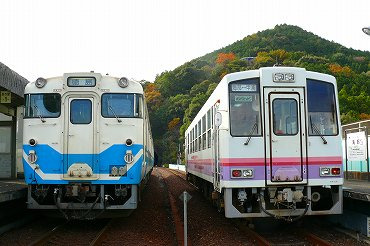
The car initially operated in the colors of the Takachiho Railway as a “Takachiho-specification car”, before it was repainted into a new livery in March 2010.

ASA-101 and ASA-301 operated in tandem until an announcement by the ASA Seaside Railway in December 2019, stating that the diesel railcars will be replaced by three DMVs (Dual-Mode Vehicle), the first known application of such a vehicle in Japan.
With the announcement made, ASA-101 and ASA-301 are slated to be retired from service, with their final runs expected to take place on 30 November 2020; after their withdrawal, a temporary bus service will ferry passengers around the railroad until the introduction of the DMVs in 2021.
As these cars are slated to retire soon, I thought it would be appropriate to put these under an In Memoriam post. As for what they are going to be doing after their retirement, I don’t know. I hope they will either be transferred to another railroad or preserved, but I have a feeling they will be scrapped.
But one can only dream.
IMAGE SOURCES ASA-100: https://getnavi.jp/vehicles/432986/ ASA-200: https://raillab.jp/photo/11390 ASA-300: https://www.kumai.com/sotetsufan/others/Asa.htm ASA-100 and 300: http://asatetu.com/ ASA-300 in original colors: http://tabinori.net/daisansector/tokushima.html DMV: http://asatetu.com/archives/1979
#阿佐海岸鉄道#ASASeasideRailway#阿佐海岸鉄道ASA-100形#阿佐海岸鉄道ASA-200形#阿佐海岸鉄道ASA-300形#AsaKaiganRailway#ASA-100series#ASA-200series#ASA-300series#InMemoriam
0 notes
Photo

Fallen Flags: KiHa 58 series Shiranui
Another one of these old JR Kyushu Joyful Trains. Very little is available in terms of information so we’ll make do with what we have.
This two-car DMU was converted from KiHa 28 2436 from the Utopia set and KiHa 58 190 from the Joyful Train Ōita set. Presumably, not much was changed in the interior.
The set began operation in August 1993 and was based at Kumamoto Depot. However, with the abolition of Joyful Trains on the JR Kyushu network, the set was retired and scrapped not even a year after it was introduced; this is probably one of the shortest-lived JR Kyushu trainsets known.
Little else is known, however it is nice to appreciate another fallen flag.
Source: http://www.ne.jp/asahi/hekkai/rail/extra/12th-spc/12th-spc28.htm
0 notes
Photo

Fallen Flags: KiHa 58 series BunBun
This was an early JR Kyushu Joyful Train that operated in JR Kyushu’s early days.
The train was converted from KiHa 58 and 28 series cars; these were inserted into the set as KiHa 58 8001 and KiHa 28 8001 respectively. It is unclear if the cars were renumbered (although it is likely they were), and if they were renumbered, what their numbers were prior to their conversion. It is also unclear what plant these were rebuilt at. The set got its name from “BunBun” splashed across the cab fronts.
The set was introduced in March 1987 during the final days of the Japanese National Railways; ownership was changed from JNR to JR Kyushu was JNR was privatized. Not much modification was done to the set.
Can you find this set today? No. JR Kyushu announced that they would be removing all Joyful Trains from service in June 1994, and that fate befell that set (JR Kyushu currently operates Joyful Train-esque services, though they are called “D&S Trains”; however, these are not considered Joyful Trains by JR Kyushu). The set was presumably scrapped afterwards. Not much other information is available on the set. Nevertheless, it is nice to take a look at another fallen flag.
Source: https://twitter.com/hideyan_osaaho/status/729301423431680000
0 notes
Photo

Fallen Flags: 165 series Yū Yū Tōkai
Another EMU Joyful Train? This is going to be interesting. As usual, let’s talk about it.
This was a special Joyful Train designed for use around the Shizuoka region. To build this train, three JR Central 165 series cars were used for the rebuild; these cars were KuHa 165-204, MoHa 165-862 and KuMoHa 165-139. These cars would become KuHa 165-101, MoHa 164-701 and KuMoHa 165-101 respectively. JR Central’s Nagoya Works was responsible for the conversion.
The cab cars were highly modified, featuring a new cab design with large front windows, modern headlamps and orange and green circles, evoking images of mikan oranges and tea. The interior features two abreast reclining seating. In the middle of the intermediate car, a stage is set. Bass speakers are placed underneath the floor for the first “body sonic” floor.
The conversion to the Yū Yū Tōkai set was completed on 28 July 1989, with service commencing on 3 August 1989 on a special Rapid service titled Yū Yū Tōkai Shinrin'yoku Ressha. It would after which also be used on various private services. Other services the train was used on included the Hananoki-Kin-Gō and most notably, the Home Liner, along the lone JR Central 371 series set. The train was labeled variously in its time in service; it was officially known as Yū Yū Tōkai, but was labeled as Yū Yū Tōkai~ on timetables.
As the train continued use, its age began to show, as well as the number of people using the train beginning to decrease; it was later relegated to mainly use on the Home Liner services. With the decreasing number of commuters and aging equipment, the set was finally retired on 11 November 1995 with one final service, titled Shizuoka Aoi Hiroshi-gō.
Can you find this train today? You’re out of luck, as usual. After the train was retired, it was struck from the roster; all equipment was then removed and the train towed to Hamamatsu Works for scrapping on 15 November. Nonetheless, it is nice to remember another fallen flag.
Source: http://blog.livedoor.jp/msyk0914/archives/52102887.html
0 notes
Photo


Fallen Flags: KiRo 82 series Resort Liner
And now we go back to DMUs. Let’s talk about this one, another one of our Joyful Trains, known as the Resort Liner.
This was a “parlor train” designed by JR Central to complement the locomotive-hauled Euroliner. To create the train to complement the Euroliner, JR Central took three ex-JR Central KiHa 28 and 58 series cars; KiHa 82 99, KiRo 80 57 and KiHa 80 801. The cars were modified at Nagoya Works. After modification, the cars became KiRo 82 801, KiRo 80 701 and KiRo 80 801 respectively. The undercarriage remains unchanged.
The cars have a unique pointed streamlined shape with a “high decker” section; cars 1 and 3 (KiRo 82 801 and KiRo 80 801 respectively) have the same basic shape, but slightly different window placement. Car 1, KiRo 82 801, features a lounge in the “high decker” section with a sofa and a table, while the lower section features four private rooms, each holding six people. The seats in the private rooms are fixed transverse seating, with each seat having a monitor and AV equipment.
Car 2, KiRo 80 701, has a stage in the mid section of the car. Four rows of reclining seats are placed next to the stage on both sides. Electronic equipment to control the karaoke and AV equipment is also available. A traditional Japanese-style toilet is also available within this car.
Cat 3, KiRo 80 801, features completely different seating from the first car, with five rows of four abreast seating on the “high decker” portion. The first and third row of seats can rotate, but the second, fourth and fifth cannot. On the rear of the seats are the world’s first cathode ray televisions. The lower deck of the car features a similar setup to KiRo 82 801, with four “semi-compartment” rooms, each holding six people; unlike the private rooms in the other car, these rooms are partitioned, but do not feature doors. A toilet is placed near these rooms; opposite the toilets is baggage storage.
The set was completed on 29 July 1988 and began operations on 16 August 1988. In later years, however, generic KiHa-type diesel railcars were used to power the set due to engine failures. Aging began to show and the set was retired in 1995.
Is this set still around? Uhh... no. The set was scrapped shortly after it was struck from the roster. This is also notable as being the very last Joyful Train on the JR Central network (unless you count the Train117 set); with the retirement of this set, no more JR Central Joyful Trains were left running. However, it is nice to appreciate another fallen flag.
Resort Liner: https://ameblo.jp/ef6627el/entry-12538260121.html Logo: http://panopano7000.cocolog-nifty.com/blog/2008/04/post_ddd3.html
#リゾートライナー#ResortLiner#キロ82系#キロ82#キハ80系#キハ80#KiRo82series#KiRo82#KiHa80series#KiHa80#JR東海#JRCentral#ジョイフルトレイン#JoyfulTrain#FallenFlags
0 notes
Photo

Fallen Flags: KiRo 59 series Elegance Acky
We’re back to DMUs after one EMU because the vast majority of Joyful Trains are just repurposed DMUs, so let’s talk about it.
The train was developed by the Japanese National Railways as a train that could be used in particular by “young people” on charter trips; as Japanese-style trains were going out of style, JNR decided to develop a European-style train for that particular crowd.
To do this, JNR took three KiHa 58 and 28 series cars, KiHa 58 1517, KiHa 28 2408 and KiHa 58 1532, and converted them into KiRo 59 503, KiRo 29 502 and KiRo 59 504 respectively. The conversion was done at JNR’s Tsuchizaki Works (today JR East’s Akita Works). The train was named Elegance Acky after a mascot that JNR’s Akita Bureau promoted.
All cars are treated as Green Cars. Anti-vibration material was added to the cars, along with a “floating floor” structure for the interior. Electric chandeliers and other light fixtures were added into the cars. The seats in all three cars were arranged in two rows of two seats which can be rotated 360° in 45° intervals. Night lights were also added, along with curtains on the side of the windows. Karaoke equipment and other AV equipment were also added. A video projector was also added, with a 50-inch screen installed on one of the walls. The in-car toilets were given an extensive refurbishment, with new mirrors and sinks. A water cooler was also attached.
The train began operations on 14 October 1985, although the common crowd to use the trains were elderly folk, contrary to JNR’s expectations. Ownership changed to JR East when the JNR was privatized. The prime movers were replaced at some point after in view of the Arcadia incident in 1988. The train was struck from the roster in 1997.
Can you find it today? No. The train was scrapped shortly after being struck from the roster. However, it is nice to appreciate another fallen flag.
Header: https://twitter.com/expresstokiwa/status/1210504225488166913
#エレガンスアッキー#EleganceAcky#キロ59系#キロ59#キハ58系#キハ58#KiRo59#KiRo59series#KiHa58series#KiHa58#国鉄#JNR#JR東日本#JREast#ジョイフルトレイン#JoyfulTrain
0 notes
Photo


Fallen Flags: 165 series Shuttle Maihama/Alpha
Finally, a Joyful Train that isn’t a DMU for once. This was a train with an interesting history behind it, so let’s get behind it.
On 1 December 1988, a section of the Keiyō Line between Minami-Funabashi and Shin-kiba Station opened; within that section was Maihama Station, allowing commuters to access Tokyo Disneyland. As such, a new train was designed as a special train that could transport commuters to Tokyo Disneyland.
To do this, JR East took cars from 165 series sets H17 and H18 to become a new set. The cars used were KuHa 165-194, MoHa 164-852 and KuMoHa 165-129. The cars were treated as normal cars, as opposed to the First Class car treatment many Joyful Trains received, with car numbers after the conversion remaining unchanged.
Of note is that apart from the color scheme and exterior body work, most elements of the train remain unchanged. The seats in KuHa 165-194 are arranged in such a fashion that it resembles the seating arrangement in a theater; the car features a pink color scheme to give a fantasying image. The seats in MoHa 164-852 are transverse seats facing each other, with central seats arranged back to back towards the windows; the car features a yellow color scheme for an adventurous image. KuMoHa 165-129 features rows of transverse seats; the car features a blue color scheme for a futuristic image.
The train began service in 1990, and was based at Makuhari Depot. It was used on the Uchibō and Sotobō Lines in some capacity; however, due to the increase in regular trains plying the area, the uniqueness of the train was lost. The train was then moved to the Nagano Depot and withdrawn from service in December 1995.
The train would then be rebranded as the Alpha and moved to Nuttari Depot (today Niigata Depot). While originally having a similar color scheme, the color scheme was later changed to a lavender paint scheme. It would be used on ski trains around the Niigata area and other temporary services. The train would be retired in 2001.
Can you find this train today? No. While there are surviving 165 series cars (3 of them to be exact), none of them are from the Alpha set; the cars were struck from the roster on 8 May 2001 and scrapped shortly after. However, it is nice to see another fallen flag.
Shuttle Maihama: https://himitsu86.blogspot.com/2009/08/blog-post_03.html Alpha: https://twitter.com/EF81503/status/1003212032760352768
1 note
·
View note
Photo

Fallen Flags: KiHa 58 series Edelweiss
Another JR East Joyful Train? Well, yes, but this one is special; I’ll get to why after the jump.
In 1987, the Japanese National Railways were privatized and divided into eight companies; six passenger, one freight and one research institute. At this time, JR East was intending to convert some cars into a Joyful Train; to do this, they took ex-JR East KiHa 28 and 58 series cars KiHa 58 744, KiHa 28 2509 and KiHa 58 619 and rebuilt them to become the Edelweiss set.
The cars were converted at JR East’s Tsuchizaki Works (today Akita Works) at JR East’s Morioka Depot. After completion, the cars were placed at Morioka Depot and began commercial operation on temporary services; unlike most Joyful Trains, the car numbers were not altered. Interestingly, the train is treated as a normal train as opposed to a first class train like with most other Joyful Trains.
The cab car had a slightly modified body design, with the driver side window being enlarged. The interior was of a Western style, with four rows of reclining seats with folding tables on the rear. In the center of the cars, a karaoke unit with video monitors was installed to divide the guest space into two. The intermediate car was converted into a lounge. Window shades were also added. A card telephone was also inserted in car KiHa 58 744, and a glass partition added to allow passengers to see the tracks ahead.
The cars began operation in December 1988 as the first Joyful Train on the JR East network. The prime movers were changed from DMH17 prime movers to DMF13 prime movers in 1992 in light of the Arcadia incident that occurred in 1988; the train’s livery was also changed completely the same year to a mellow lavender paintscheme. The train also operated on the temporary Rias Sealiner service in 1999 and 2000. The train was taken out of service on 28 July 2001 with one final service titled Goodbye Edelweiss, and was struck from the roster on 1 November 2002.
Usual question, where can you find this? Again, you’re out of luck; the train has been scrapped. However, it is nice to appreciate another old fallen flag.
Header: https://twitter.com/EF81503/status/986240938841272320
0 notes
Photo


Fallen Flags: KiHa 59 series Viva West
This one looks rather modern for its time, actually. This is another one of JR West’s early Joyful Trains, and I’ll be going through a bit of its history.
This was the second Joyful Train produced by JR West after it was privatized from the Japanese National Railways, the first being the Resort Saloon Festa, a strange carp-shaped train with the ability to “talk” through pre-recorded voice clips.
To make this new train, two ex-JR West KiHa 58 series cars were taken for modification. These two cars were KiHa 58 176 and KiHa 28 2132. Rebuilding was done at Hatabu Works (today Shimonoseki Works), with new bodies being fitted. After the rebuild, the cars were given new numbers; KiHa 58 176 and KiHa 28 2132 became known as KiHa 59 501 and KiHa 29 501 respectively.
The bodies of the cars were highly modified to become a square shape, with a large front windshield to improve frontal views. The body is painted ivory white with sky blue and pink accents. The interior is noted to be rather similar to a Limited Express train, with reclining bucket seats and foldable tables which can be turned into armrests. Curtains are also attached to the windows and the lighting has been changed. Near the diaphragm is a “free space” with a sofa and karaoke equipment.
The set was completed on 20 July 1989 and stationed at Ogori Depot (today Yamaguchi Depot). Operations began some days later in late July, with a special event held at Hiroshima Station to welcome the train to service. It would then embark on a special Blue Liner service. The train would then be used for various special services after, but as is the case with trains converted from DMUs from the ‘50s and ‘60s, age is a concern; as such, the train was withdrawn from service in March 1999, a mere nine years after it entered service.

Again, eternal question, where can I find this yada yada yada. As with most cases, you’re out of luck; the train was struck from the roster and scrapped shortly after at Takatori Depot. In spite of this, it is nice to appreciate another fallen flag.
Viva West: https://twitter.com/kutunoura6/status/829346159302832128 Logo: https://twitter.com/simo70270864/status/1219633554784690178 Takatori: https://ken-k.cocona.jp/phto171/jrwjt10.htm
#ビバ・ウエスト#ビバウエスト#VivaWest#キハ58系#キハ58#KiHa58series#KiHa58#キハ59系#キハ59#KiHa59series#KiHa59#JR西日本#JRWest#ジョイフルトレイン#JoyfulTrain#FallenFlags
0 notes
Photo


Fallen Flags: Hokkaidō Chihoku Kōgen Railway CR70/CR75 series
This is an old NDC-type diesel railcar operated by the short-lived Hokkaidō Chihoku Kōgen Railway based in a rather obvious area of Japan (no points for guessing where it is). These were the only known rolling stock owned by the company.
In 1987, with the privatization of the Japanese National Railways, a 87 mi (140 km) line known as the Chihoku Line had its ownership transferred to the newly incorporated JR Hokkaido. On 14 November 1988, however, JR Hokkaido officials felt it would be appropriate to change ownership of the line, giving it to a third-sector railway company. A poll would then be held to decide on the new name of the line.
On 20 January 1989, the name of the new line was announced: the Furusato Ginga Line (lit. Hometown Galaxy Line). A new company, known as the Hokkaidō Chihoku Kōgen Railway, would be founded on 9 March, and locomotives for the line to be built. JR Hokkaido’s request for the transfer of ownership of the Chihoku Line would be approved shortly after, with the final date of operation set at 3 June that year; on 4 June, the line was officially taken over by the Hokkaidō Chihoku Kōgen Railway and operations on what would now be known as the Furusato Ginga Railway started.
The vehicles used to run this line were the CR70 and CR75 series diesel railcars, all built by Niigata Tekkō (now known as Niigata Transys). These cars were built from 1988 to 1990; these are generally considered identical to JR Hokkaido’s KiHa 130 series Hidaka railcars. Eight CR70 series and four CR75 series cars were built, making a total of twelve cars. The cars are equipped with DMF13HS prime movers.
These cars began operation on 4 June 1989 with the opening of the Furusato Ginga Line. By 2000 however the number of passengers on the line decreased, and as such two cars, CR70-4 and CR70-5, were taken out of service and struck from the roster. After being struck from the roster, these were used as spare parts donors before eventually being scrapped in 2007.
A decision was later made in 2005 to abolish the line due to falling passenger numbers, with the last date of operation set at 20 April 2006, just seventeen years after the line started operation. The day after, the line closed for good. The ten remaining cars used for service before the line closed then each went through different final fates.
And now the eternal question: where do I find them? You are in luck; all ten cars survive today. Three (CR70-1 — CR70-3) went to Myanmar, where they operate on the Myanmar Railways, six (CR75-1 — CR75-4, CR70-7 — CR70-8) went to the Rikubetsu Railway, where they are preserved in operational condition, and the last car, CR70-6, has an interesting story.
After it was retired, CR70-6 was initially sold to a private individual located in Saitama Prefecture, who intended to convert it into a train simulator located in Esashi in Hokkaido. However, the highly prohibitive costs of transport eventually caused this plan to fall through, eventually being canceled altogether in September 2007, with the car sent for scrap.
Before the car could be scrapped, however, the car was taken by a chairman of a Social Welfare corporation in based in Kitami. It was then stripped of its bogies and placed on display next to the now-closed Furusato Ginga Shokudō restaurant. So yes, stories like this can have happy endings.
Exterior: https://raillab.jp/photo/237/L Interior: http://www.agui.net/tasya/hck/hckCR70-21-30.html
#北海道ちほく高原鉄道CR70形#北海道ちほく高原鉄道CR75形#CR70形#CR75形#HokkaidōChihokuKōgenRailway#CR70series#CR75series#FallenFlags
0 notes
Photo

Fallen Flags: 155/159 series
These were a series of 13 sets of two related trains mainly used for school excursion services in the 1960s to 1980s. These were set up in 4- or 8-car sets.
The 155 and 159 series sets were constructed from 1959 to 1962 by Kisha Seizō and Nippon Sharyo respectively; 48 155 series cars and 16 159 series cars were produced, making 64 cars in total.
Originally classified as the 82 series, the 155 series were built from 1959 to 1961 entered service on 20 April 1959, and would be used on the Hinode and Kibō school excursion services; it was because of their use on the Hinode service that they were nicknamed the Hinode-type trains. They would be reclassified the 155 series on 1 June 1959 due to the nomenclature revision that year.
The very similar 159 series sets would be built from 1961 to 1962 and enter service on 12 April 1961. These were used on the Komadori and Wakaya school excursion services. Both trains were painted in “lemon yellow” with “scarlet red” accents to signify that they were used on these services.
The Hinode and Kibō services were discontinued in March 1971, while the Komadori and Wakaya services were discontinued in March 1973; after this, the trains were painted into the highly distinctive Shōnan orange paint scheme used on various JNR trains of the time.
As more powerful and modern trains began to show up on the JNR, the age of the 155 and 159 series trains began to show, especially since they were not air conditioned compared to other JNR trains which were being introduced around the time. As such, they were slowly retired; the 159 series sets, despite being newer, were retired first, in 1980. The 155 series sets followed suit three years later in December 1983.
Now comes the eternal question: where are they now? Well, you’re out of luck. The trains were sequentially scrapped after they were retired, so all we have now are just these few photographs to document their history. As usual, it is nice to document another fallen flag.
Source: https://twitter.com/ArukasFoto/status/1116819274230898688
0 notes
Photo

Kawasaki SWIMO
This is an experimental “gigacell-powered” streetcar designed by Kawasaki Heavy Industries.
The SWIMO is touted as being: “equipped with the high capacity, fully sealed nickel-metal hydride battery GIGACELL”, which allows the train to “eliminate the need for power supply lines while offering the spacious comfort of a truly modern low-floor light rail vehicle.” SWIMO stands for “Smooth Win Mover”.
One demonstrator unit was manufactured and tested on various lines in Japan (particularly up north) from 2006 to 2008. It was also tested alongside RTRI’s LH02 car on the Sapporo Streetcar, which employed a similar concept. The set has never been used for any sort of commercial operation.
Around 2010, the Okayama Electric Tramway said that they were considering putting a streetcar based on SWIMO technology into operation; these plans appear to have fallen through. The set presumably is still located at Kawasaki’s headquarters.
0 notes
Photo

Musical horns on Japanese railways
Okay, today’s post is not about a train in particular, but about musical horns. These have been an interesting way of communication around various railroads, with those that adopted it having their own unique tunes. We’ll go through the railroads that used it and make note of their tunes. Click on any of the “Type x” markings to hear a recording of the horn.
Odakyu Electric Railway

Arguably the first company in Japan to use a musical horn, it was originally called a “music box” and used an endless loop of tape to produce the melody. The first known train with the musical horn was the 3000 series Super Express (shown above). Technology later improved and the musical horns eventually became electronic. However, this may have annoyed residents living around the vicinity of the railroad as the horns were a bit noisy, and as such they were not used for a long time or removed from the trains themselves; this was revived in 2006 with the introduction of the 50000 series Vault Super Express, with the horn becoming a mainstay on the Odakyu network once again.
Known vehicles Type 1: tape 3000 series Super Express (retired)
Type 2: early electronic 3000 series Short Super Express (retired) 3100 series New Super Express (changed to Type 3) Type 3: electronic 3100 series New Super Express (retired) 7000 series Luxury Super Express (retired) 10000 series High Super Express (retired, removed, no known recordings) 20000 series Resort Super Express (retired, removed no known recordings)
Type 4: modern 50000 series Vault Super Express 60000 series Multi Super Express 70000 series Graceful Super Express
Nagoya Railroad (Meitetsu)

Probably the first to come up with the idea of a musical horn for their trains; to showcase their technology of their horns, Meitetsu named them the “transistor horn”. The technology used for the horn has improved over time. The horns are nicknamed the “Dokeyo horn” as townsfolk would see the trains passing by at high speeds and blasting these musical horns to warn that a train is coming and adding nonsensical lyrics to the tune. There was an attempt at changing the melody of the horn; response to that was unanimously negative, so the horn was returned to its original melody. Meitetsu actually attempted to trademark the sound of its musical horns in 2016; the filing was rejected by the Japanese Patent Office.
Known vehicles Type 1: transistor, fast 7000 series Panorama Car (retired) 7300 series Panorama Car (removed, retired) 7700 series Panorama Car (retired) KiHa 8000 series (retired)
Type 2: transistor, slow (pitch may vary) 7000 series Panorama Car (retired) 7500 series Panorama Car (retired) 7700 series Panorama Car (retired)
Type 3: warbling tone 1000 series Panorama Super 8800 series Panorama DX (retired)
Type 4: trumpet synth 1600 series Panorama Super (retired, rebuilt) 1700/2300 series 2000 series μSky 2200 series EL120 series
Special 1000 series Blue Liner (removed and replaced with Type 3 horn)
Kinki Nippon Railway (Kintetsu)
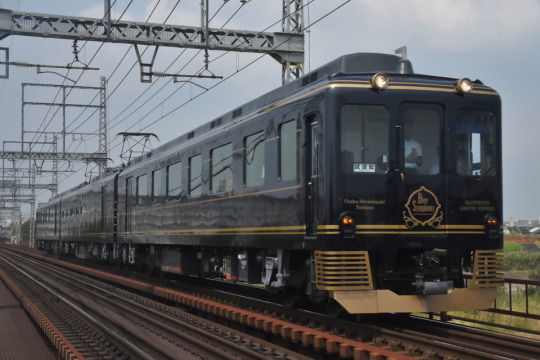
Okay, while technically not a musical horn in the traditional sense, it is considered as one by Kintetsu, so it’s going on here. Kintetsu does not normally use musical horns for their trains, but this the only one that uses this “musical horn”; it plays an arrangement of Joseph Hadyn’s Symphony No. 101: The Clock, 2nd Movement through speakers located between the cars.
Known vehicles Type 1: classical music 16200 series Blue Symphony
Shizuoka Railway (Shizutetsu)
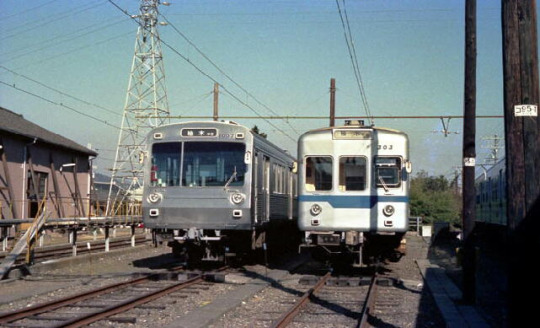
The horn history can be traced back to the 1960s with the introduction of the 300 series; the melody was changed in the 1970s with the introduction of the 1000 series and has been that way since. The musical horn is dubbed the “Electronic Alarm”, and is activated using a switch; pushing that switch plays the melody twice. The horn in its current state is only played after 7am.
Known vehicles Type 1: early melody 300 series (changed to Type 2)
Type 2: current melody 300 series (retired) 1000 series A3000 series Shizuoka Rainbow Train
Japanese National Railways (JNR, Kokutetsu)

Fitted for a brief time from 1963 to 1969 on KiHa 58 series cars. These were known as “Music Sirens” and cars equipped with it featured additional red bands around their bodies.
Known vehicles Type 1: music siren KiHa 58 series (removed, no known recordings)
Japan Railways Group (JR) As the JR Group is so huge, I’ll need to split it into multiple sections to cover it all.
East Japan Railway Company (JR East)
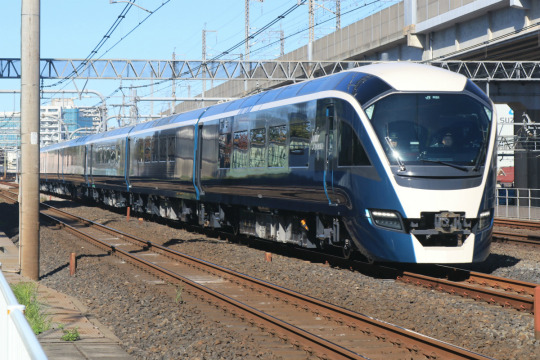
I believe JR East was the first JR Group company to use musical horns for their trains. These often use a six-note ditty from a synthesizer with a warbling tone, although there are some exceptions.
Known vehicles Type 1: warbling tone, early version 251 series Super View Odoriko (retired) 253 series Nikko 485 series Hana 485 series Kirakira Uetsu (retired) 485 series New Nanohana (retired) 485 series Resort Express Yū (retired) 485 series Resort Yamadori 485 series Seseragi (rebuilt) 485 series Utage (retired) 485 series Zipangu
Type 2: warbling tone, later version E001 series Train Suite Shiki-Shima E257 series Odoriko E259 series Narita Express E261 series Saphir Odoriko (replaced with Type 4) E353 series Super Azusa E491 series East i-E 651 series Super Hitachi E653 series Fresh Hitachi E655 series Nagomi E657 series Super Hitachi E751 series Tsugaru
Type 3: seven-note 255 series Bōsō View Express E351 series Super Azusa (retired)
Type 4: Saphir Odoriko E261 series Saphir Odoriko
West Japan Railway Company (JR West)
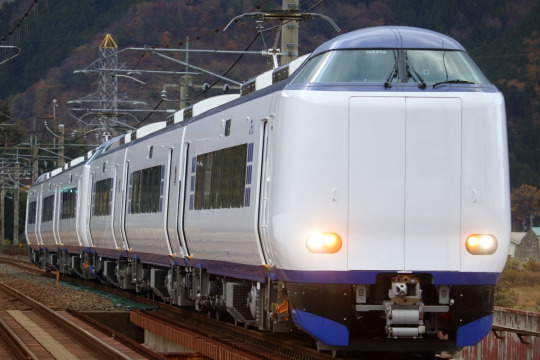
The musical horns here are noticeably much simpler, featuring catchy ditties with French horn-esque sounds and synthesizers.
Known vehicles Type 1: arpeggio 87 series Twilight Express Mizukaze 271 series Haruka 281 series Haruka 283 series Ocean Arrow 285 series Sunrise Express 287 series Kounotori 289 series Kuroshio 681 series Thunderbird 683 series Thunderbird
Type 2: tinny seven-note tune 125 series 207 series 223 series 225 series 227 series Red Wing 321 series 323 series 521 series
Central Japan Railway Company (JR Central)
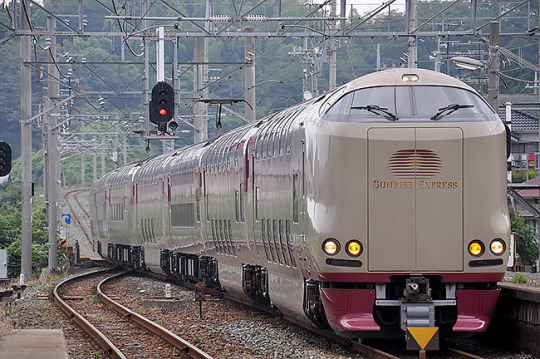
Musical horns are normally not installed on JR Central locomotives due to an internal rule within JR Central seemingly prohibiting such things. The only known exception to this is the 285 series, which was jointly developed by JR West and JR Central.
Known vehicles Type 1: arpeggio 285 series Sunrise Express This musical horn is identical to JR West’s type 1 horn.
Shikoku Railway Company (JR Shikoku)

As with JR Central, musical horns are not normally installed on JR Shikoku’s locomotives, although there are no internal rules dictating as such. However, they are used on two Joyful Trains used on the railroad. However, as with the Kintetsu Railway, these are not exactly true musical horns per se, but more correctly music being pumped through speakers through something like a MIDI file.
Type 1: tinny seven-note tune 5000 series Marine Liner This musical horn is identical to JR West’s type 2 horn.
Special KiHa 47 series Iyonada Monogatari KiHa 185 series Shikoku Mannaka Sennen Monogatari KiHa 185 series Shikoku Tosa Toki No Yoake No Monogatari
Kyushu Railway Company (JR Kyushu)
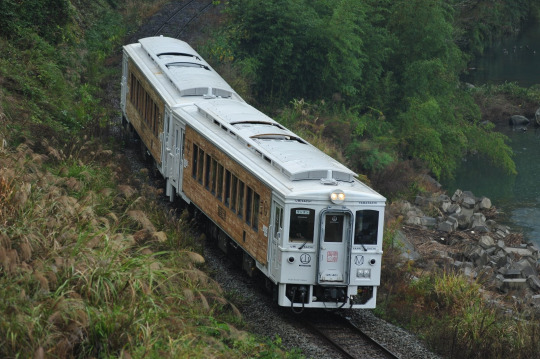
As with JR Central, musical horns are not normally installed on JR Kyushu’s locomotives, although there are no internal rules dictating as such. However, it is used on one Joyful Train used on the railroad, along with some Limited Express locomotives. However, as with the Kintetsu Railway, these are not exactly true musical horns per se, but more correctly music being pumped through speakers through something like a MIDI file.
Known vehicles Type 1: jolly tune 883 series Wonderland Express 885 series Shiroi (no known recordings) DF200-7000 Seven Stars in Kyushu These horns are never used in regular service, and as such are very difficult to hear unless at a special event.
Special KiHa 125 series Umisachi Yamasachi (has two “horns”; one for arrival, one for departure)
Tokyo Metropolitan Transportation Bureau (Toei)
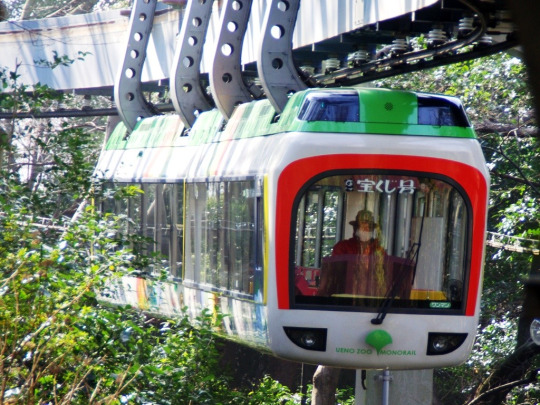
As with JR Central, musical horns are not normally installed on Toei’s locomotives, although there are no internal rules dictating as such. However, there is (or more correctly, was) a musical horn installed on the Ueno Zoo Monorail that Toei used to operate before the line was closed in October 2019.
Known vehicles Type 1: warbling tone 40 series Takarakuji (retired) This musical horn is identical to JR East’s type 2 horn.
Metropolitan Intercity Railway Company (Tsukuba Express)

The horn is selectable between two settings: an electric horn or a musical horn.
Known vehicles Type 1: kettle drum-like melody TX-1000 series TX-2000 series TX-3000 series (potentially? Confirmed through Twitter video)
Keisei Electric Railway
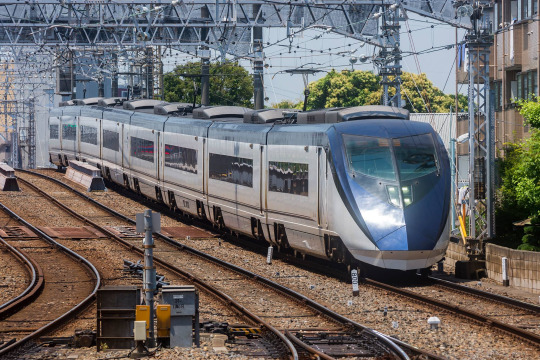
This horn is only used on one locomotive. It is a horn tune which was composed by Minoru Mukaiya, former keyboardist for the band Casiopeia; the tune was actually unveiled about a year before the trains were built.
Known vehicles Type 1: regal horn tune AE series
Keio Electric Railway
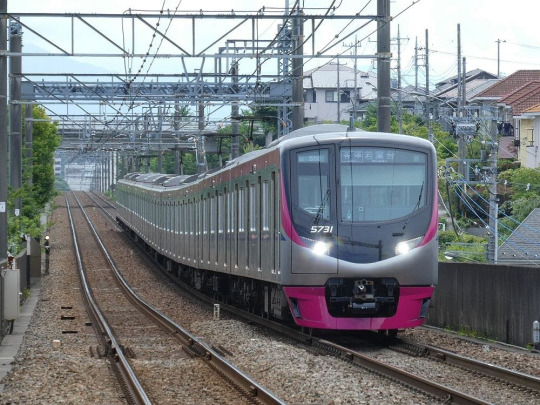
This horn is only used on one locomotive. It is usually used during Keio Liner services.
Known vehicles Type 1: regal-sounding seven-note ditty 5000 series (5731 only)
Type 2: synthesized seven-note ditty 5000 series (5732 onward)
Other smaller railways Various smaller railways have had musical horns on their locomotives as well; I’ll document some of these. In this section, click or tap the name of the railroad to hear the horn (if applicable).
Tenryū Hamanako Railway (Tenhama) The musical horns are pumped through a “melody IC” manufactured by PATLITE. A number of tunes can be selected. This is usually only used at special events. Known vehicles TH9200 series
Enshū Railway (Akaden) Identical to the original Type 1 Meitetsu horn. Fitted on 30 series set 34F for a brief time but was then removed. Known vehicles 30 series (removed, retired)
Enoshima Electric Railway (Enoden) Plays a simple music box tune. Fitted as part of a trial in 2012 but was later removed. Known vehicles 1000 series (removed)
Nagano Electric Railway (Nagaden) Identical to JR East’s Type 1 horn. Vehicles were transferred over with minor modifications so the horn stays. Known vehicles 2100 series (ex-JR East 253 series)
Joshin Electric Railway Very similar to JR East’s Type 2 horn. Not used in normal service so extremely difficult to hear. Known vehicles 1000 series (removed) 6000 series
Toyama Chihou Tetsudou (Chitetsu) Has two distinct types of musical horns; one for normal railed vehicles and another for streetcars. The railed vehicles have an original tune, while the streetcars play a music box-like rendition of Bach’s Minuet in G Major. The horn for the heavy railed vehicles was removed in the 1990s. Known vehicles Type 1: electronic 10020 series (removed, retired) 14760 series (removed)
Type 2: music box Most streetcars on the network
Fukui Railway (Fukutetsu) Trains do not normally have musical horns; however, the 300 series trains transferred from the Shizuoka Railway featured musical horns until those were removed. Horn is identical to Shizuoka Railway Type 2 horn. Known locomotives 300 series (ex-Shizutetsu 300 series, retired)
WILLER TRAINS/Kitakinki Tango Railway Music box-like horn fitted on one locomotive that plays Over The Rainbow manufactured by Seiko Epson. Removed in 2013. Known locomotives KTR001 series Tango Express (removed)
Hisatsu Orange Railway Music box-like horn manufactured by Seiko Epson fitted on two locomotives, usually played during events; one plays Toy Cha-Cha-Cha and the other Happy Birthday. Both cars are currently used for regular operations, making it very difficult to hear the horn. Known locomotives HSOR-100 series (151 and 152 only)
IR Ishikawa Railway Identical to JR West’s Type 2 horn. Vehicles were transferred over with minor modifications so the horn stays. Known vehicles 521 series (ex-JR West 521 series)
Ainokaze Toyama Railway Identical to JR West’s Type 2 horn. Vehicles were transferred over with minor modifications so the horn stays. Known vehicles 521 series (ex-JR West 521 series)
Hokuetsu Express Identical to JR West’s Type 1 horn. Vehicles were transferred over with minor modifications so the horn stays. Ownership of all vehicles have been transferred back to JR West, so these horns can no longer be heard on the Hokuetsu Express. Known vehicles 681 series Hakutaka (ex-JR West 681 series) 683 series Hakutaka (ex-JR West 683 series)
Akita Nairiku Jūkan Railway Music box-style horn fitted on one locomotive. Only used at events so this horn is extremely difficult to hear. Known vehicles AN2000 series (no known recordings)
Sapporo Streetcar/The Iyotetsu Co., Ltd/Tosaden Kōtsū etc. Short seven-note musical ditty played through speakers. A modern version played at a slightly slower speed is also known to exist. Known vehicles Type 1: music box Most Sapporo Streetcar/Iyotetsu/Tosaden Kōtsū etc. vehicles Kawasaki SWIMO RTRI LH02 series
Type 2: modernized music box Sapporo Streetcar 1100 series Sirius Tosaden Kōtsu 3000 series Heartram II Iyotetsu MoHa 5000 series
So there you have it. All the musical horns that I can document so far. And now, the sources for the images and all the relevant tags.
Header: https://www.bilibili.com/read/cv378025/ Odakyu: https://e233-3000tokaidoline.blogspot.com/2019/05/201920190526.html Meitetsu: http://den221.blog66.fc2.com/blog-entry-32.html Kintetsu: https://2nd-train.net/topics/article/12266/ Shizutetsu: http://www7a.biglobe.ne.jp/~dts/page297.html JNR: https://twitter.com/washu_exp/status/717702782904442881 JR East: https://news.mynavi.jp/article/20191121-e261saphirodoriko/ JR West: https://sazzly.hateblo.jp/entry/2019/12/03/185902 JR Central: https://dime.jp/genre/536589/ JR Shikoku: http://photozou.jp/photo/show/491121/194636694?lang=zh JR Kyushu: https://www.toretabi.jp/railway_info/entry-731.html Toei: http://train.gomi.info/train-uenokensuisen.html Tsukuba Express: https://raillab.jp/photo/31214 Keisei: https://www.facebook.com/OxfordRoad.photo/photos/a.420672121734640/422404088228110/?type=3&theater Keio: http://www.rail-7.com/2018/07/wakabadai-5000.html
ADDENDUM Shinano Railway Newest musical horn discovered on any Japanese railroad. Known locomotives SR1 series Last updated: 19 January 2022
#ミュージックホーン#MusicalHorn#小田急#名鉄#近鉄#静鉄#国鉄#JR東日本#JR西日本#JR東海#JR四国#JR九州#都営#秋田内陸縦貫鉄道#天竜浜名湖鉄道#つくばエクスプレス#京成#京王#長野電鉄#IRいしかわ鉄道#あいの風とやま鉄道#札幌市電#とさでん交通#伊予鉄道#江ノ電#遠州鉄道#上信電鉄#富山地方鉄道#福井鉄道#WILLERTRAINS
2 notes
·
View notes
Photo

New Kids on the Block: The Six New Locomotives
Today is 14 March, the date where various train timetables are revised on various Japanese railroads. And also the date when new locomotives are introduced. Today, I’ll briefly run through the six locomotives that will be introduced on the various railroads in Japan today, along with an image of them in service on their first day, if applicable.
JR Hokkaido H100 series DECMO

This is a hybrid diesel railcar patterned after the JR East GV-E400 series cars. The cars are intended to replace the KiHa 40 series cars on the railroad, which were about 40 years old. The name “DECMO” stands for “Diesel Electric Car with MOtors”.
JR East E261 series Saphir Odoriko
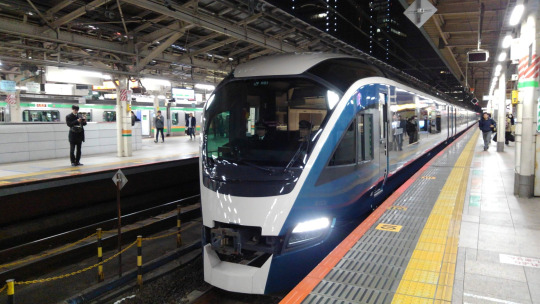
Replacing the 251 series Super View Odoriko sets, this is train with an air of class around it, with a panoramic front view, regal colors and a new and unique musical horn. Two sets have been produced: RS1 and RS2. They are, however, not of the “high decker” design.
JR West 271 series Haruka
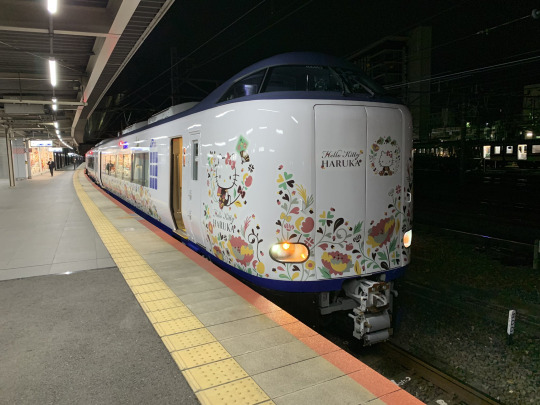
Painted in a unique Hello Kitty paintscheme, these trains are intended to supplement the 281 series Haruka trains. They are basically a modernized version of the 281 series, featuring an extremely similar shape, front profile, livery and even the same musical horn, but they don’t have the blue “JR” on their roofs.
JR Kyushu YC1 series Yasashikute Chikaramochi Hybrid

Featuring a fully-lit up front with stainless steel sides, the YC1 series cars are JR Kyushu’s first hybrid trainsets. The trains are based at Sasebo Depot. 3 sets are slated to be produced and they are used on the Sasebo, Ōmura and Nagasaki Main Lines.
Kintetsu 80000 series Hinotori
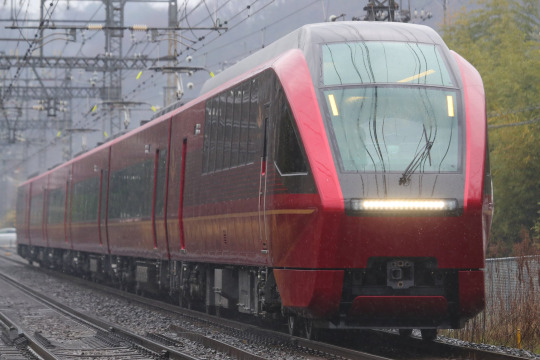
Intended to be a new train to ferry passengers between Nagoya and Osaka, the 80000 series trains are the newest Limited Express trains on the Kinki Nippon Railway (Kintetsu) network. The sets can be either 6 or 8 cars in length. The train is branded Hinotori, literally translating to “firebird”.
Tsukuba Express TX-3000 series

A new design of train on a constantly evolving network of railroads in Tokyo, the TX-3000 series sets built by Hitachi are the newest rolling stock on the Tsukuba Express, the sole line run by the Metropolitan Intercity Railway Company. The trains are six cars in length, but are prepared for possible lengthenings to eight cars each.
Honorable Mention: JR East E257 series Odoriko

Okay, while technically this isn’t a new train, it’s been repurposed to be used on a different service. In this case, the E257 series sets were originally used on the Azusa and Kaiji services; however they were replaced by the E353 series Super Azusa sets on both, so the sets were converted for use on the Odoriko service, being given slightly new programming in their LED screens, new headlamps and a new paintscheme replicating that on the Saphir Odoriko.
So there you have it. The six (or seven) trains that entered service today. Let’s give them a welcome, shall we?
Header: https://twitter.com/FjigateOne/status/1238277784352350208 H100: https://twitter.com/mamocha13478942/status/1230108683763212288 E261: https://twitter.com/cureallstars063/status/1238387720050708480 271: https://twitter.com/3mCub/status/1238568361077772288 YC1: https://twitter.com/SUGOCA817/status/1238574993874665472 80000: https://twitter.com/masayuki2831/status/1238606361606230016 TX-3000: https://twitter.com/hamutaro2016/status/1238594846056542208 E257: https://twitter.com/257_Sustina46/status/1238621965251801088
#JR北海道#JR東日本#JR西日本#JR九州#近鉄#つくばエクスプレス#JR北海道H100形#H100形#JRHokkaidoH100series#JRHokkaidoH100#H100series#DECMO#JR東日本E261系#E261系#JREastE261#E261series#スーパービュー踊り子#SaphirOdoriko#JR西日本271系#271系#JRWest271#271series#はるか#Haruka#JR九州YC1系#YC1系#JRKyushuYC1#YC1series#優しくて力持ちハイブリッド#YasashikuteChikaramochiHybrid
1 note
·
View note
Photo


In Memoriam: 251 series Super View Odoriko
Looks like we have another “In Memoriam” post... this time, it’s about the 251 series Super View Odoriko. One of the first double-deck trains on the JR East network, this train has a unique appearance with triple headlamps on the front and a “high decker” style.
Designed with the theme of “Izu is over there when you ride” (this is a very loose translation), the trains were initially designed with a design with colors evoking that of the Izu Peninsula. The cars are apparently designed quite similarly to the Izukyu 2100 series Resort 21 trains.

The cars were built from 1990 to 1992 by Kawasaki Heavy Industries and Kinki Sharyo, and were originally done up in a gray and white paint scheme. The trains were based on 651 series undercarriages, and also use the same resistor control system with field system superimposed field excitation control.

The first two sets, RE1 and RE2, would be built in 1990 and delivered in April 1990. The sets entered service on 28 April 1990. The set would later receive the 1991 Laurel Prize, an award given to the train with the most outstanding functional and design features, with a formal ceremony taking place at Shinagawa Station on 1 March 1992. The other two sets, RE3 and RE4, were delivered in 1992.
The sets are ten-cars in length and are arranged in the following formation: KuHa 251-x―SaHa 251-x―MoHa 251-x―MoHa 250-x―MoHa 251-x―MoHa 250-10x―MoHa 251-10x―MoHa 250-x―SaRo 251-x―KuRo 251-x (x represents set number, i.e. if set is RE4, cars will be named KuHa 251-4, MoHa 250-4 etc.) All cars feature one plug door per side.
MoHa 251-0 cars (i.e. MoHa 251-1), cars 6 and 8, feature pantographs and the main resistor control units. They are of a “high decker” design and seat 64 in total. Toilets are fitted in the cars.
MoHa 251-100 cars (i.e. MoHa 251-101) are practically identical; both feature pantographs and main control units, both seat 64 passengers and toilets are fitted. This is car number 6 in a set.
MoHa 250-0 cars are motor-generator cars equipped with compressors. The car seats 56 with toilets and a “mini-lobby”; these are cars 3 and 7 in the set. Car 7 was originally a smoking car; all cars were made no smoking on 17 March 2007. Passengers cannot pass through the gangway between cars 3 and 2.
MoHa 250-100 cars are intermediate cars with a “high decker” structure. The car seats 48, but do not feature a motor-generator or compressors. A service counter with stand and a card telephone are installed. This is car 5 in a set.

KuHa 251 cars are one of two double-decker cab cars; this is car 10 in a set, facing in the direction of Tokyo. The front portion is of a “high decker” design, with there being clear glass between the passengers and drivers’ cab (which is slightly lowered). The car can sit 36 passengers, with the bottom floor being a children’s play space.

KuRo 251 cars are the other of the two double-decker cab cars; this is car 1 in a set, facing in the direction of Izukyu-Shimoda. The front portion is of a “high decker” design, with there being clear glass between the passengers and drivers’ cab (which is slightly lowered). Considered a Green Car (first class), this car seats 14 in 2+1 abreast reclining seats on the top floor. The bottom floor is a lounge with a goods stand catering to those in First Class. Toilets and luggage storage are provided.

SaHa 251 cars are intermediate cars with a “high decker” style; this is car 9 in a set. The car seats 64. This is the only handicapped car, with barrier-free toilets; however, the car does not have barrier-free seats, with the multipurpose room to be used instead for that purpose.
SaRo 251 cars are double-decker intermediate cars; this is car 2 in a set. Considered a Green Car (first class), this car seats 25 in 2+1 abreast reclining seats on the top floor. The bottom floor features 3 private lounges seating twelve people. Toilets, service counters and luggage storage are also fitted. Flat screen televisions are located inside each of the private lounges.
The sets were noted as being high-class for the time, compared to the 185 series sets which were also being used on the Odoriko services at the time. The sets themselves underwent a refurbishment program in 2002 to 2004, aiming to improve various amenities inside the trains.
As the trains were used, their age began to show; it was then announced that the trains would be retired with the introduction of the new E261 series Saphir Odoriko sets. Set RE1 would be used for this last run. The set, as of the time of writing, is currently running on its final run, so it’ll be nice to see the set for the last time before it is either preserved or scrapped.
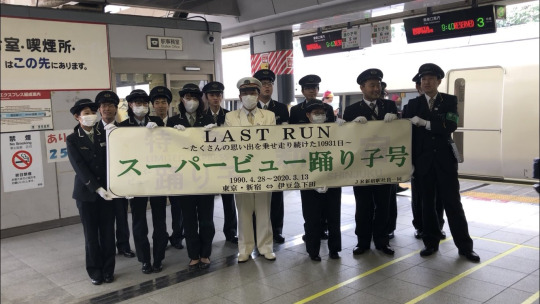
251: https://twitter.com/fukunaga_E257/status/1236147908174442496 SVO logo: https://tetsumaru.jp/user/tanchicke/photo/2414/ Old colors: https://ameblo.jp/kitatetu-dd/entry-12552858352.html Delivery: http://d51498.com/past/19900407/ Nifty interior pictures: http://kiha81.com/jreast-251/ Observation: https://ameblo.jp/chiefhayate/entry-12365861213.html Last run: https://twitter.com/ActyE231e2331/status/1238268445424103424
2 notes
·
View notes
Photo

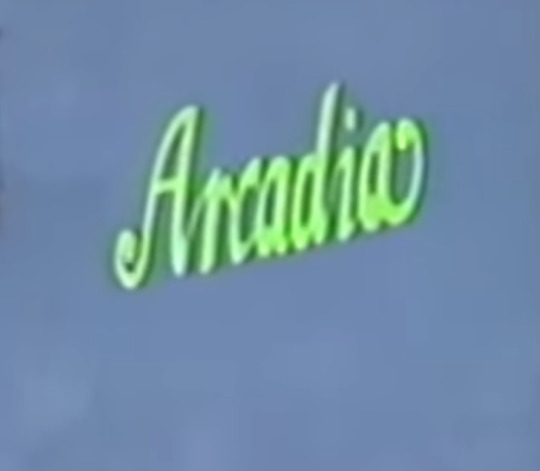

Fallen Flags: KiHa 58 series Salon Express Arcadia/Kenji
Finally, a trainset that isn’t one from JR Hokkaido! Here’s one of JR East’s Joyful Trains, and likely the first one that JR East ever operated. Why do I say this? You’ll find out later.
The Salon Express Arcadia was a concept design started by the Japan National Railways’s Niigata Division in the mid-1980s. The idea was to make a European-style train with an extremely high quality interior allowing passengers to fully enjoy the mood of travel through relaxing in the trains.
Three KiHa 28 and 58 series cars were selected by JNR for the rebuild; KiHa 58 626, KiHa 28 2010 and KiHa 58 650 were selected by JNR to become KiRo 59 508, KiRo 29 505 and KiRo 59 509 respectively. The conversion was completed on 25 March 1987.
The train featured a red livery evoking the snow camellias around the area, with blue accents evoking the Sea of Japan and white evoking the color of snow. The cab cars featured a six-piece windshield with a wiper on each of the six glass panels, and are built in a “high decker” style. The observation decks of the cab cars feature eight pairs of reclining seats. All the three cars are treated as Green Cars (equivalent of first class cars).
Behind the observation decks of the cab cars were the general guest cabins; these were also done in a similar high decker style. Two columns of reclining seats are featured, with a multi-channel stereo system and earbuds; the remote control to change the various channels is built into the armrest. The interior is done in a green color scheme.
The exterior of the intermediate car, KiRo 29 505, was not modified much, although the interior was a completely different story. Luggage racks were removed and the entire floor was carpeted; shoes were not allowed in this car, so shoeracks were installed at the entrance and exit doors of the car. 24 sofas and a table were arranged inside the car, although these could be freely rearranged on an event-to-event basis. The interior color was also made brown.
Other changes included the lighting; five chandeliers were installed as the main lighting, along with two spotlights, ten bracket lights (both of which were dimmable) and a seven-color light machine were installed on a wall on the side. At one end of the car, a counter was present, along with a fridge, coffee machine and sink; however, no utensils or cooking equipment was provided. At another end of the car, a 37-inch screen was attached, hooked up to an audio system with six microphone jacks and four hanging speakers for surround sound; these were intended to be used for karaoke.
After the conversion was completed, JNR was heavily in debt and was subsequently privatized and divided into eight companies (JR East, JR West, JR Central, JR Kyushu, JR Hokkaido, JR Shikoku, JR Freight and the Railway Technical Research Institute); the set’s ownership would be transferred to JR East, thereby technically making the Saloon Express Arcadia the first Joyful Train owned by JR East.
Operation began in April 1987 after JR East came into existence. The train would be stationed at Niigata Depot and would be used on various services around the Niigata area. Approximately a year after the train entered service, however... tragedy struck.
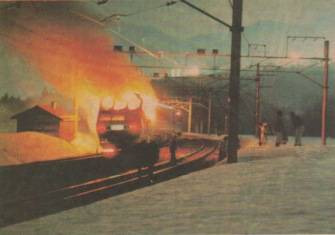
On 30 March 1988, as the Salon Express Arcadia was traveling on the Jōetsu Line and passed through the Arashimizu Tunnel; as it emerged, the exhaust pipe of cab car KiRo 59 508 overheated, causing a catastrophic failure. The car was set ablaze and made an emergency stop between Echigo-Nakazato and Iwappara Skiing Ground Stations. The car remained burning for 45 minutes until the fire was put out; the car was then scrapped while the other two cars were withdrawn from service with immediate effect, marking the end of the Salon Express Arcadia. This incident was dubbed the Arcadia incident.
The train however was not struck from the roster; in the mean time, the remaining cars were being rebuilt into a completely new set. An additional car KiHa 58 series car, KiHa 58 1505, was then converted to be inserted into this new set.
While the set was being converted, a number of higher-ups at JR, including Isamu Yamashita, JR East’s president at the time, having received a report on the Arcadia incident, requested for a blueprint of the DMH17H engines used by the train to study, thinking it was one of the potential causes of the incident. On seeing the blueprints, he roared: “Is this a prewar engine? Why are we still using such an engine?” (the engine itself was designed in 1960, but was based on prewar technology; Yamashita was able to spot these traits as he was an engineer) Fearing a repeat of such an incident, Yamashita ordered the immediate replacement of all DMH17H engines on all trains; all engines were replaced by 1992, and this would affect the rebuilt Salon Express Arcadia.
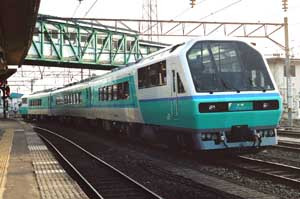
On 11 March 1992, the train was completely rebuilt with the new replacement car inserted, given a new color scheme resembling that of JR West’s 383 series Kuroshio trains and given new engines; the cars were also renumbered from their numbers during the Salon Express Arcadia days back to their original numbers prior to their initial conversion; the cars would be renumbered KiHa 58 1505, KiHa 28 2010 and KiHa 58 650, their original numbers prior to their refurbishment. The cars were also given a downgrade from Green Cars to Standard Cars.
The train was initially named the Sanriku Marine Liner when it entered service in March 1992; sometime later, the train was renamed the Kenji, after noted poet Kenji Miyazawa. The train in its Kenji guise was based at Morioka Depot. The train was later given a new paintscheme of green with a golden stripe; this was changed to blue with a golden stripe in December 2013.
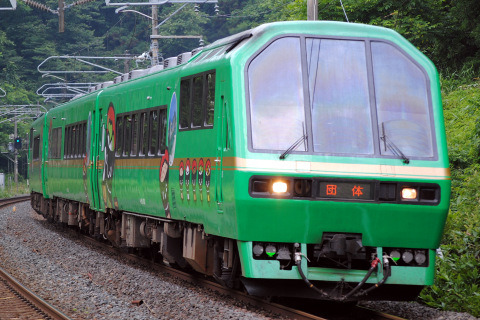
The train would be used for various temporary services, along with sometimes being used for general usage. As the train saw use, the trains’ age began to show; the train was ultimately retired on 8 September 2018. With that, all KiHa 58 series cars, whether retired or. The train was then towed to Akita Depot for scrapping.
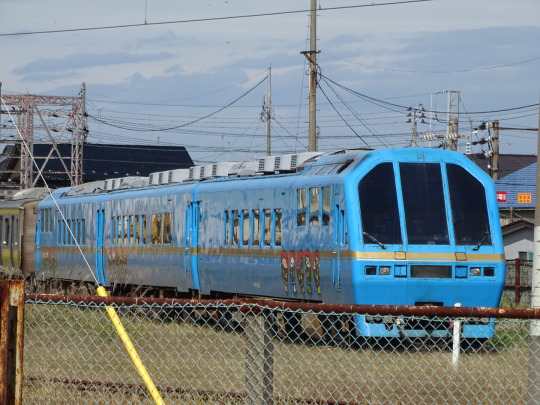
If you are trying to look for this set, the locomotive is still apparently located at the Akita Depot as of 2019; I am not sure if it has been moved or scrapped. However, you cannot actually enter the depot unless you are an employee, and so you can only take pictures of the train from afar. If it has been scrapped, then you’re out of luck, but it the train still remains there, that will likely be the very last time you can see it.
Salon Express Arcadia: http://www.ne.jp/asahi/hekkai/rail/extra/12th-spc/12th-spc36.htm Logo: https://youtu.be/sK7sutrrkqo (usual YouTube comments, can’t find any good photos of the logo on the net) Blue Kenji: https://2nd-train.net/topics/article/9233/ Incident: http://www.nct9.ne.jp/kiro59/arcadia.htm Sanriku Marine Liner: https://kitafukuoka.darumaotosi.com/004_resort_joyful.htm Green Kenji: https://blog.2nd-train.net/trainnews/?p=1414 Kenji in Akita: https://twitter.com/mari6bus/status/1048448162497617920
#サロンエクスプレスアルカディア#SalonExpressArcadia#Kenji#キハ58系#キロ59系#キロ59#国鉄#JREast#JR東日本#JNR#KiHa58series#KiHa58#KiRo59series#KiRo59#ジョイフルトレイン#JoyfulTrain#FallenFlags
0 notes